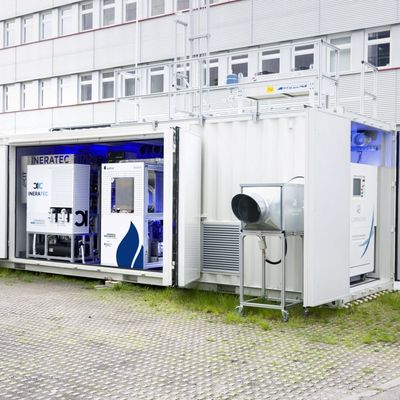
In a clearing on the edge of the Black Forest in southern Germany, a modified shipping container painted an immaculate white sits near a field of solar panels. Inside, ducts wrapped in insulating foil elbow between racks filled with cabinet tanks. Everything is motionless and silent, except for a soft whirring and humming. Michael Klumpp, a postdoc at the Karlsruhe Institute of Technology, turns a spigot and a clear liquid flows into a glass flask. The substance smells faintly of warm wax. Though it resembles oils derived from plants or petroleum, it does not come from any familiar source, but has literally been pulled from the thin air, transubstantiated from gas to liquid with the help of renewably generated electricity. On a mass scale, it could be used to fly airplanes or power heavy machinery, replacing petroleum in some situations. It even has a catchy name: eFuel.
The idea of turning air into liquid fuel may sound fantastical, but the underlying principle is as mundane as a head of lettuce. “It’s the same thing that plants do with photosynthesis,” says Roland Dittmeyer, leader of the project and director of the Institute for Micro Process Engineering at KIT.
While the machine that I watched produce that energy-dense liquid in the forest clearing is just the first stage of a pilot program, the underlying technology could help reshape the battle against climate change. The project, called P2X, is part of the Copernicus Project, an initiative to prepare Germany for a carbon-neutral economy by 2050. The $40 million demonstration phase was supported by 18 research institutions and 27 industrial firms, including Siemens, Volkswagen, Shell, and ThyssenKrupp.
The process begins with a module, built by Climeworks of Switzerland, that extracts carbon dioxide from the ambient air. The device blows air over a filter that absorbs CO2 and then releases the gas in concentrated form when heated. An adjacent unit, built by a Dresden-based firm, produces hydrogen by splitting water molecules through high-temperature electrolysis. In the third module, built by a Swiss tech company, a reaction called Fischer-Tropsch Synthesis fuses the carbon and hydrogen to produce hydrocarbons, the same carbon chains that make up gasoline, kerosene, coal, and natural gas.
The science behind each step has been understood for decades; what’s new is the fusion of the processes into a compact, efficient system. “Fischer-Tropsch has been known for 100 years,” says Klumpp. “It’s putting the steps together that’s hard.” The heat produced by the synthesis reaction, for example, is repurposed to optimize the temperature for electrolysis.
The hydrocarbon fuels in use today are extracted from the Earth. When they are burned, they release carbon dioxide that drives climate change. What’s coming out of the tap in Karlsruhe is different. So long as the energy used to make it comes from renewable sources, this synthetic hydrocarbon mix — the P2X team came up with the name “eFuel”— is carbon neutral when burned. And if the hydrocarbons are turned into materials like plastic, the end product is carbon negative.
The prototype stage of P2X on display today runs on 10 kilowatts of electrical power and produces seven liters of fuel per day. Phase two, currently under construction and scheduled for completion next year, will be several times larger and use 200 kilowatts to produce 200 liters of fuel per day. Sometime around 2025, phase three will come online, with the capability of turning a megawatt of electricity into 1,600 liters of fuel per day.
Dittmayer says that if the will is there, production could scale up much faster. “We have proposed to build a 100-megawatt plant that would give you in the range of 35-to-40,000 tonnes per year,” he says. “The idea would be to have that in maybe five years.” That quantity of fuel would be enough for three daily 747 flights between New York and Los Angeles.
A major hurdle for eFuel is always going to be cost. Today’s fossil fuels contain energy created by photosynthesis hundreds of millions of years ago. The energy in eFuel comes from freshly generated electricity, and that’s expensive. To make matters worse, only about half of that energy winds up in the output fuel. All told, Nikita Pavlenko, of the nonprofit think tank the International Council on Clean Transportation, says eFuel “would be at least four to eight times more expensive” than fossil fuel.
As the technology improves, Klumpp believes that the cost of eFuel could come down considerably — perhaps, he says, to as low as $7 per gallon. While that sounds expensive to U.S. consumers, it’s close to what gasoline costs in Germany today.
Even if eFuel remains expensive, it will prove viable if there exists a niche for which there is no other option. In a radically decarbonized economy of the future, that niche may be commercial aviation. With air travel growing fast in the developing world, aviation emissions have nearly doubled over the last decade and are now responsible for an estimated 2 to 3 percent of total global greenhouse-gas emissions. Facing pressure from activists, the international aviation organization IATA has set the goal for airlines to cut emissions in half by 2050.
How to achieve that? Researchers have explored replacing fossil-derived jet fuel with biofuels, but available quantities will probably never be adequate to serve the 40 million or so flights that take place each year. Another option would be to power aircraft with batteries, but these, too, face steep hurdles. Even the most advanced batteries carry only about one-fiftieth as much energy-per-unit weight as fossil fuels, meaning electric planes are severely limited in payload and range. In a demonstration last December, Canada’s Harbour Air test-flew a modified Beaver floatplane billed as “the world’s first electrically-powered commercial passenger aircraft.” But the flight only lasted four minutes, and so much of the aircraft’s payload was taken up by batteries that there was no room for passengers.
Jet fuel made from air and clean electricity would suffer neither of these problems. Production would be scalable without limit, and problems with energy density would vanish. What’s more, aircraft manufacturers would avoid spending decades pursuing regulatory approval for new propulsion systems. Running on eFuel, the engine technology of today could continue to power the airliners of tomorrow.
Several parallel efforts are under way to bring eFuel to aviation. The Canadian government has established the “Sky’s the Limit Challenge,” which will award $1.5 million to the competitor that develops “the cleanest, most affordable, and sustainable aviation fuel.” The government has already invested $19 million in one company, British Columbia–based Carbon Engineering, which is building a plant to produce 320 liters of eFuel per day.
In the Netherlands, a consortium led by EDL Anlagenbau is conducting a study on building a plant at the Rotterdam airport that could produce 1,000 liters of jet fuel a day, using electricity from on-site solar panels. And U.K. jet-engine manufacturer Rolls-Royce is leading a consortium that aims to produce synthetic fuel using electricity from nuclear reactors.
Some experts, however, are less than sanguine. In 2018, the International Council on Clean Transportation published an analysis which concluded that for eFuel to succeed commercially, it would require subsidies of $10 to $13 per gallon. A much more affordable way to decarbonize aviation, says Pavlenko, is through offsets, which are “much, much cheaper than alternative fuels.”
But if we’re really going to combat climate change, we have to stop taking hydrocarbons from the ground and burning them. “There are sectors where you need the high energy density of hydrocarbons,” Klumpp points out. “And if you want to do this CO2 neutral, you somehow have to synthesize them using renewable energy.”
































